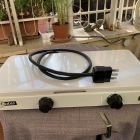500 years of the Vatican Museums.
Five hundred years ago, on 14 January 1506, a large and beautifully intricate marble sculpture was discovered in a vineyard at the Terme di Tito on the Colle Oppio in Rome. The sculpture depicted the Trojan priest Laocoon and his two sons being strangled to death by giant sea snakes, a fate bestowed by the gods after Laocoon nearly scuppered the plan of smuggling the Greeks into the besieged city in the belly of a giant wooden horse. The work was excitedly identified as the Laocoonte mentioned in Plinys Natural History, where it was attributed to three sculptors from Rhodes and said to belong to the emperor Titus (79-81AD), although experts are now undecided on whether the statue is an original (40-30BC) or a copy (14-37AD).
Upon hearing of the statues discovery, Pope Julius II (1503-1513) bought it to stand in pride of place in the elegant courtyard garden of the Palazzetto di Belvedere within the Vatican walls. With this acquisition, the long history of the Vatican art collection began, and today the museums house masterpieces from across the centuries. The museums are now halfway through the special programme of openings and events celebrating their fifth centenary this year.
We have selected some of the most recent and important research and conservation projects, choosing diverse themes that best represent the intricate complexity of these museums, Francesco Buranelli, director of the museums, explained.
The celebrations began in March with the reopening to the public of the modernised Christian Museum, first established by Pope Benedict XIV in 1756-1757 to host small early Christian objects such as coins and precious stones as well as antiquities found during the excavations of the catacombs. Previously situated in the Vaticans Apostolic Library and then in the Lateran Palace, the museum was moved to its present location in the Vatican Museums in 1999 by the wish of Pope John Paul II, where it has now been systematically restored with artifacts organised according to their origin.
In April, 15th-century mural paintings by Pinturicchio in the Borgia apartments Sala dei Misteri went on display after being hidden from sight under tapestries for over 30 years. The frescoes were commissioned by the colourful Pope Alexander VI (1492-1503) and cover the walls of three rooms, immortalising both the popes family and his numerous concubines, who are depicted as fair-faced madonnas. Since restoration work began on the portraits in 2002, valuable information has been gathered on the painting technique of the period, such as the creation of pigment by mixing eggs, oil and glue.
The most recent initiative has been the reopening to the public in June of the Ethnological Missionary Museum, beginning with its Asian section. Artifacts from China, Japan, Korea, Tibet and Mongolia are now on display, bearing witness to a wealth of cultures and traditions and the influence that Buddhism, Christianity and Islam have exerted on the various local customs. Special attention is given to the theme of inculturation the different ways in which the Christian message has been reinterpreted and proposed by indigenous cultures. Many of the artifacts on display were gifts sent to Pope Pius XI (1922-1939) from all over the world on the occasion of the 1925 jubilee year from the various international missionary institutes and orders, and he founded the museum as a result.
It is a sad fact that indigenous people werent treated respectfully but too often treated as inferiors by Europeans, said the Vatican Museums curator, Monsignor Roberto Zagnoli. The Vatican has an important role in promoting a message of respect and tolerance for different cultures and religions. We want to highlight the richness in diversity and also that the role of the missionary is one of dialogue and not of conquest or proselytism. In total the missionary museum possesses over 80,000 artifacts, and more of these will go on display when the three further sections open to the public. An Oceania section is set to be completed by the end of 2007, an African section by 2009 and a section on the Americas by 2010.
Further events are planned for the next six months. In September, the Vatican post office is to release a commemorative stamp bearing the image of the Laocoonte, and this will be followed in October by the opening of the Roman necropolis on a section of the old Via Triumphalis. Discovered by chance in 2003 during work on a new car park inside the Vatican walls near Piazzale di S. Rosa, the necropolis preserves around 30 burial buildings and a large number of single graves dating from the first to the third century AD, mostly in excellent condition, and some decorated with mosaics, frescoes and stucco. It also provides a fascinating source of information on burial rituals, with altars, sarcophagi, oil lamps and pitchers among the artifacts recovered. Visits by the public will be available on request.
Finally, in November the museums will stage an exhibition celebrating their foundation entitled Laocoonte. The Origins of the Vatican Museums, which will focus especially on the discovery and influence of the Laocoonte throughout the ages. Among the artists who have studied and copied the masterpiece are Sansovino, Primaticcio, Anton Raphael Mengs, Girolamo da Carpi, Rubens and Pannini.
The number of visitors to the Vatican Museums has almost doubled since 1996, and in 2005 around four million people from around the world braved long queues, often in pouring rain or under a sweltering summer sun, for a glimpse of the treasures. Museum authorities have explained that the wait has less to do with security checks than the fact that the museums were initially designed as a private collection and are struggling to cope with visitor demand. Possible solutions to the long wait, including a sheltered underground passage, have been under review for some time, but for the moment it seems that the public will have to continue to suffer for its art.

















